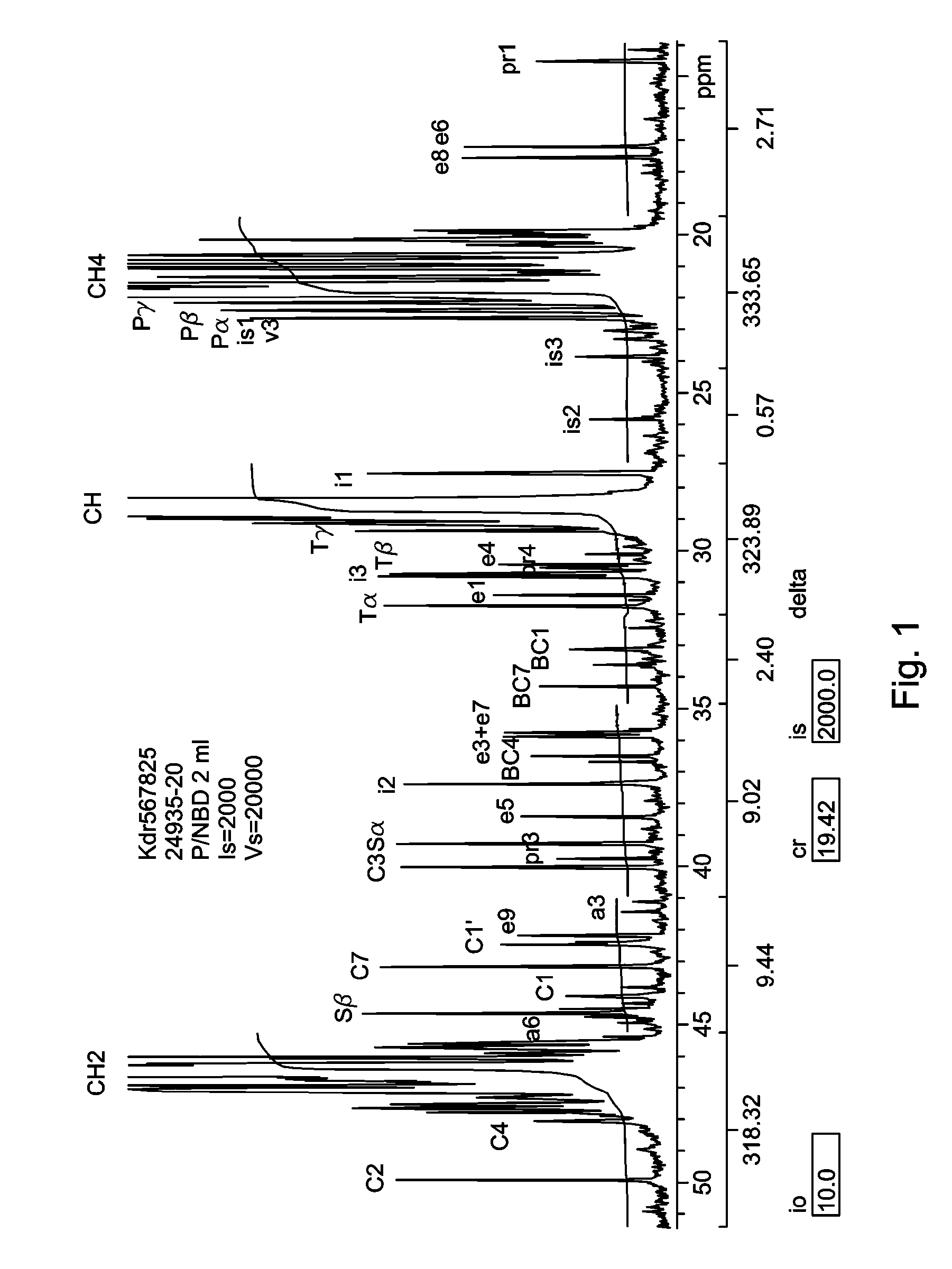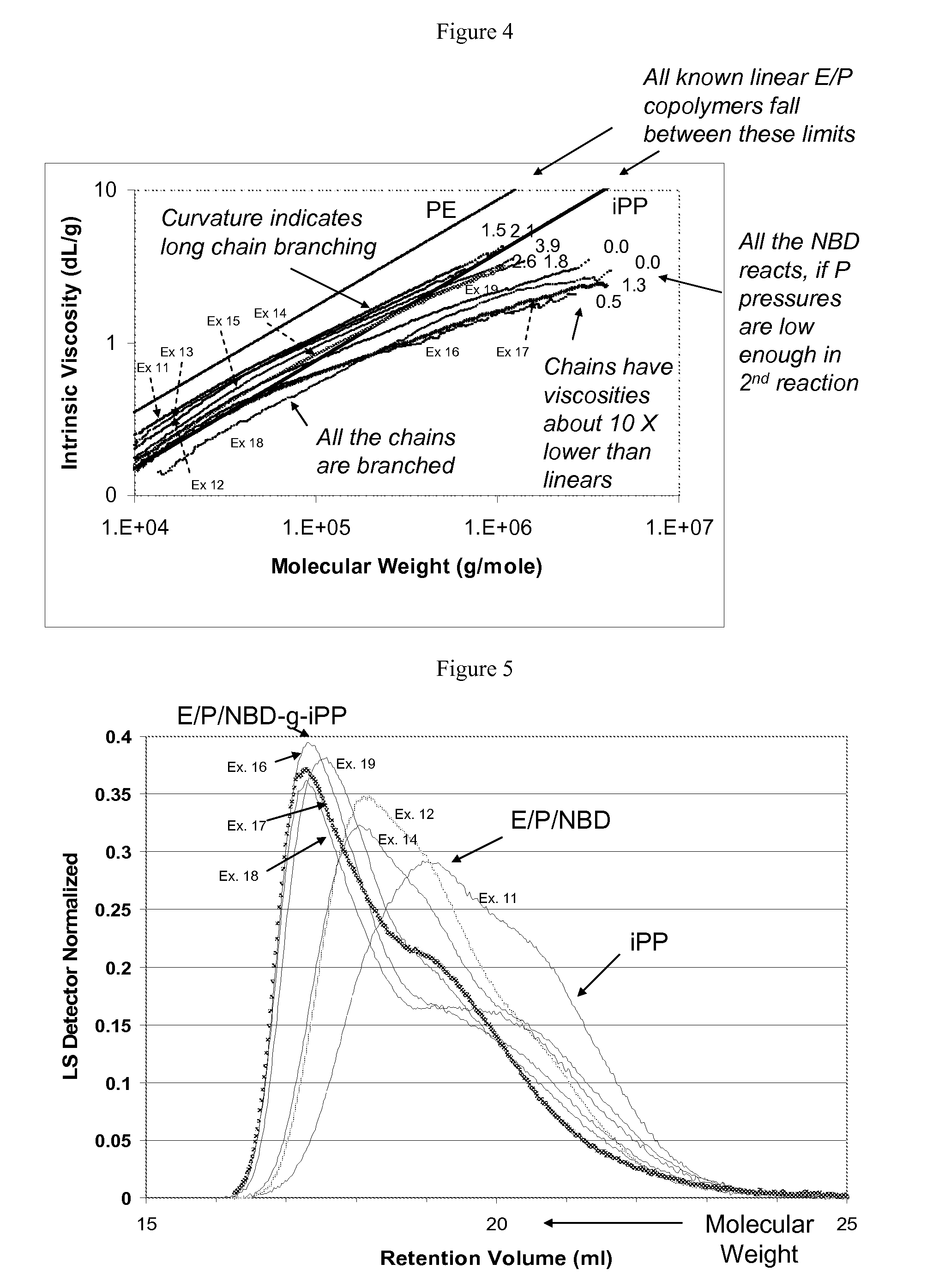In-Reactor Polymer Blends
a technology of in-reactor polymer and blend, which is applied in the field of in-reactor polymer blend, can solve the problems of inability to ep-ipp cross-products, formation of undesirable high molecular weight materials typically referred, and inability to soluble catalysts, and achieves the effect of higher ethylene conten
- Summary
- Abstract
- Description
- Claims
- Application Information
AI Technical Summary
Benefits of technology
Problems solved by technology
Method used
Image
Examples
examples 1 to 5
[0216]A series of copolymers of propylene and norbornadiene were produced using the conditions summarized in Table 1 below. The catalyst system comprised a dimethylsilyl bis(2-methyl,4-phenyl indenyl)zirconium dimethyl (cat 1) precatalyst activated by dimethylanilinium tetra(perfluoronaphthyl)borate (act 1) dissolved in toluene. 100 mL of propylene in 150 mL of toluene with 0.10, 0.25, 0.50, 1.00, and 2.00 mL of norbornadiene added were the monomer concentrations. The polymerizations were conducted at 100° C. and the pressures under these conditions were from 180 to 280 psig.
[0217]The polymerizations were carried out in an Autoclave Engineers 0.5 liter zipperclave with mechanical stirring. Temperatures were controlled using a steam jacket with an Omega PID controller. After purging the autoclave for at least two hours using dry nitrogen, dry, air free toluene was introduced using a sight glass. The norbornadiene was cannellated into the reactor while dry nitrogen was flowing. The pr...
example 6
[0226]In Example 6 propylene / norbornadiene copolymers made in the first polymerization zone are further reacted with ethylene and propylene in a second polymerization. The catalyst solution comprised 15 mg. rac-dimethylsilyl bis(2-methyl,4-phenyl indenyl)zirconium dimethyl (cat 1) precatalyst activated by 28 mg dimethylanilinium tetra(heptafluoronaphthyl)borate (act 1) dissolved in 115 ml of toluene. The catalyst solution was prepared in a drybox and then cannellated into a catalyst feed bomb. The polymerizations were carried out in an Autoclave Engineers 0.5 liter zipperclave with mechanical stirring. Temperatures were controlled using a steam jacket with an Omega PID controller. After purging the autoclave for at least two hours using dry nitrogen, 50 ml of dry, air free toluene was introduced using a sight glass. 1.0 ml of 1 molar tri(isobutyl)aluminum in hexane (TIBAL) and 1.0 ml of norbornadiene were cannellated into the reactor. For the first polymerization 100 mL of propylene...
examples 7 to 9
[0230]A series of copolymers of ethylene, propylene, and norbornadiene were produced using the conditions summarized in Table 3 below. The catalyst system comprised a rac-dimethylsilylbis(2-methyl,4-phenyl indenyl)zirconium dimethyl (cat 1) precatalyst activated by dimethylanilinium tetra(perfluoronaphthyl)borate (act 1) dissolved in toluene. 1.0 ml of one molar tri(isobutyl)aluminum solution in hexane and 0.50, 1.00, and 2.00 mL of norbornadiene were dissolved in dry, air free toluene in the drybox. The scavenger / diene solution was then cannellated into the reactor. 100 ml of toluene and 100 ml of propylene were added using a sight glass. The reactor was stabilized at 70° C. and the head pressure for ethylene was set at 150 psig higher than the reactor pressure. At the start of the reaction the ethylene feed was opened and the reactor pressure rose to the ethylene head pressure. During the reaction, ethylene flowed into the reactor under the control of a pressure regulator to maint...
PUM
| Property | Measurement | Unit |
|---|---|---|
| Temperature | aaaaa | aaaaa |
| Temperature | aaaaa | aaaaa |
| Temperature | aaaaa | aaaaa |
Abstract
Description
Claims
Application Information
 Login to View More
Login to View More - R&D
- Intellectual Property
- Life Sciences
- Materials
- Tech Scout
- Unparalleled Data Quality
- Higher Quality Content
- 60% Fewer Hallucinations
Browse by: Latest US Patents, China's latest patents, Technical Efficacy Thesaurus, Application Domain, Technology Topic, Popular Technical Reports.
© 2025 PatSnap. All rights reserved.Legal|Privacy policy|Modern Slavery Act Transparency Statement|Sitemap|About US| Contact US: help@patsnap.com



